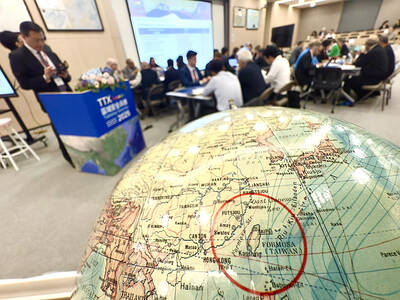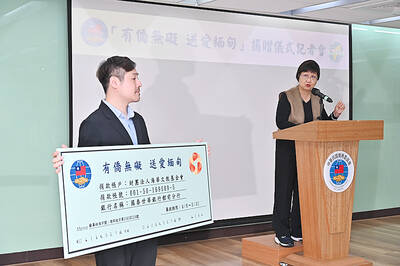Construction crews yesterday morning laid the first pier foundation for the Kinmen Bridge (金門大橋), the National Freeway Bureau said, adding that it is confident that the bridge would be finished by 2021.
The bridge would connect Greater Kinmen (大金門) and Lieyu (烈嶼, also known as Little Kinmen), the two main islands in the county, the bureau said.
It would span a strip of sea whose bed is on average 7m below the surface, it said, adding that in some areas the seabed is about 20m below the surface.
The geological complexity has made it impossible to lay the pier foundations using steel sheet piles, so the construction crews used the steel cofferdam method, the bureau said.
This was the first time the method was used by the bureau to lay a pier foundation, which took two months to complete, it said, adding that it should be able to lay the other pier foundations faster.
The bureau in March laid a foundation pile on granite.
The bureau yesterday explained the challenges of applying the steel cofferdam method.
The crews first installed jacketed steel pipes as a support base before beginning the construction, it said.
They assembled the steel cofferdam on land before lowering it to a designated depth using 12 large hydraulic jacks, the bureau said, adding that divers worked 3m to 9m below the sea surface to install bottom boards for the cofferdam and seal the plates between jacketed steel pipes.
Crews then pumped in concrete to form a 1.5m-thick bedding at the bottom of the cofferdam before pumping out the seawater trapped inside the structure, it said.
The cofferdam had to withstand buoyancy of more than 1,000 tonnes and tidal effects twice per day, the bureau said, adding that the crews installed six jacketed steel pipes and buoyancy-resistant steel piles to reinforce the structure.
Divers were kept on standby during the construction in case seawater leaked into the cofferdam, it said.
The bridge project has been criticized for “only surfacing during elections.”
The Legislative Yuan’s budget center has said in a report that the project had several issues, such as low budget implementation efficiency and construction delays.

DEFENSE: The National Security Bureau promised to expand communication and intelligence cooperation with global partners and enhance its strategic analytical skills China has not only increased military exercises and “gray zone” tactics against Taiwan this year, but also continues to recruit military personnel for espionage, the National Security Bureau (NSB) said yesterday in a report to the Legislative Yuan. The bureau submitted the report ahead of NSB Director-General Tsai Ming-yen’s (蔡明彥) appearance before the Foreign and National Defense Committee today. Last year, the Chinese People’s Liberation Army (PLA) conducted “Joint Sword-2024A and B” military exercises targeting Taiwan and carried out 40 combat readiness patrols, the bureau said. In addition, Chinese military aircraft entered Taiwan’s airspace 3,070 times last year, up about

Taiwan is stepping up plans to create self-sufficient supply chains for combat drones and increase foreign orders from the US to counter China’s numerical superiority, a defense official said on Saturday. Commenting on condition of anonymity, the official said the nation’s armed forces are in agreement with US Admiral Samuel Paparo’s assessment that Taiwan’s military must be prepared to turn the nation’s waters into a “hellscape” for the Chinese People’s Liberation Army (PLA). Paparo, the commander of the US Indo-Pacific Command, reiterated the concept during a Congressional hearing in Washington on Wednesday. He first coined the term in a security conference last

A magnitude 4.3 earthquake struck eastern Taiwan's Hualien County at 8:31am today, according to the Central Weather Administration (CWA). The epicenter of the temblor was located in Hualien County, about 70.3 kilometers south southwest of Hualien County Hall, at a depth of 23.2km, according to the administration. There were no immediate reports of damage resulting from the quake. The earthquake's intensity, which gauges the actual effect of a temblor, was highest in Taitung County, where it measured 3 on Taiwan's 7-tier intensity scale. The quake also measured an intensity of 2 in Hualien and Nantou counties, the CWA said.

The Overseas Community Affairs Council (OCAC) yesterday announced a fundraising campaign to support survivors of the magnitude 7.7 earthquake that struck Myanmar on March 28, with two prayer events scheduled in Taipei and Taichung later this week. “While initial rescue operations have concluded [in Myanmar], many survivors are now facing increasingly difficult living conditions,” OCAC Minister Hsu Chia-ching (徐佳青) told a news conference in Taipei. The fundraising campaign, which runs through May 31, is focused on supporting the reconstruction of damaged overseas compatriot schools, assisting students from Myanmar in Taiwan, and providing essential items, such as drinking water, food and medical supplies,